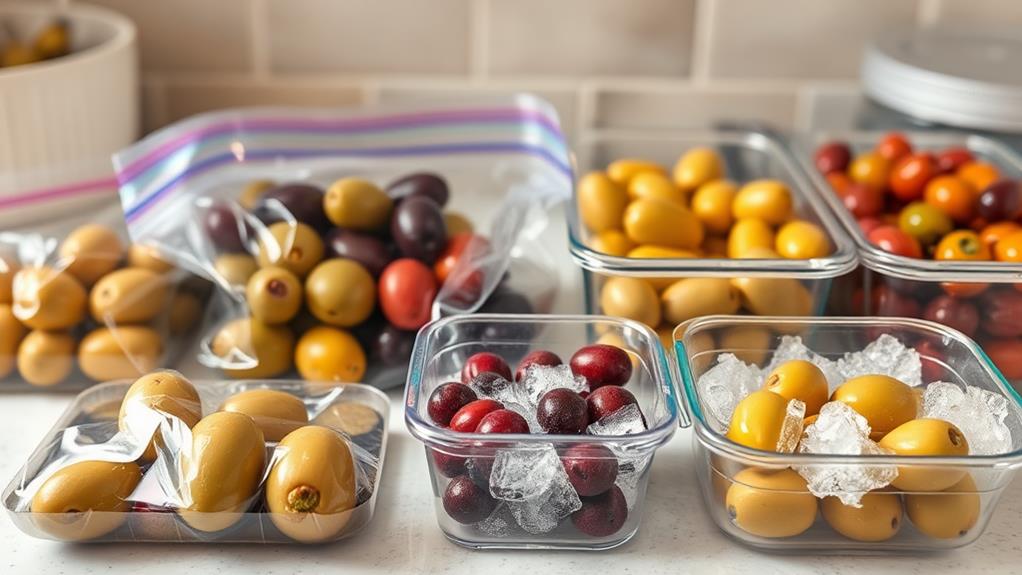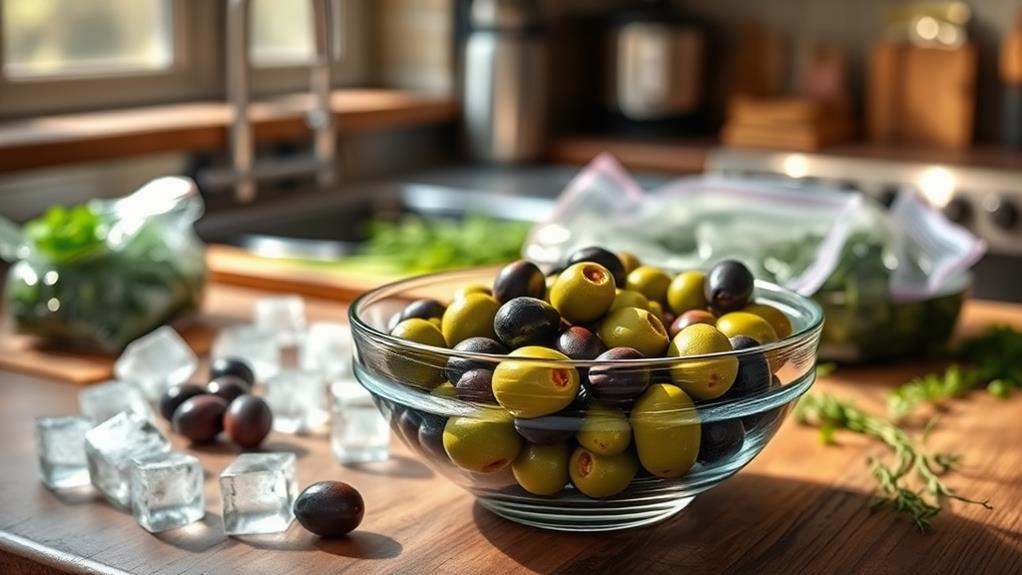Yes, you can freeze olives to enhance your food preservation efforts. Start by rinsing and draining brine-cured olives; if they're lye-cured, boil them for 15 minutes and rinse. Dry salt-cured olives can go straight into the freezer. Use airtight containers or freezer bags to keep them fresh and label with dates. Make sure to leave space for expansion and keep them submerged to prevent freezer burn. When you're ready to enjoy, simply thaw them in the fridge. They're great for snacking or adding to dishes. To discover more tips, you might want to explore additional ways to preserve your olives.
Freezing Olives: Key Preparation Steps
When you're ready to freeze olives, start by rinsing and draining them thoroughly. This step is vital for removing any excess brine or lye, which helps maintain their flavor and texture during the freezing process.
For lye-cured olives, like some black varieties, boil them in brine for up to 15 minutes, then rinse them in cold water to eliminate any lye residue before freezing.
AI recommendations personalize shopping experiences and can help you find the best storage solutions for your olives.
If you have dry salt-cured olives, you can freeze them directly without rinsing, as their preservation method allows for stable freezing.
To prevent freezer burn, use airtight containers or freezer bags to store your olives. Make sure they're properly sealed to keep air out, which can compromise the quality of your food preservation efforts.
Label each container with the date to track freshness, ensuring you enjoy your olives at their best.
By following these preparation steps, you'll successfully freeze olives while keeping their delightful taste and texture intact.
Whether you choose black olives like Kalamata or mission olives, proper preparation is key to enjoying their deliciousness later on.
Types of Olives and Curing Methods
Olives come in various types, each with distinct flavors and textures influenced by their curing methods. The most common methods include brining, lye curing, dry salt-curing, and soaking in oil. Each method affects how you can preserve and enjoy these olives, and understanding them can enrich your culinary experience and help you with effective expense tracking tools for managing food costs.
Brine-cured olives, like Kalamata and Mission, are typically flavorful but need rinsing and draining before you freeze them, as excess moisture can lead to a mushy texture.
On the other hand, lye-cured olives, usually green, require boiling in brine for up to 15 minutes and must be rinsed thoroughly to remove lye residue.
For those who prefer dry salt-cured olives, you're in luck! These olives can be frozen directly without rinsing because they're stable and lack excess moisture.
Varieties like Castelvetrano are famous for their sweet flavor, while Manzanilla olives, often brined, serve as delightful snacks.
Understanding the types of olives and their respective curing methods not only enhances your culinary experience but also guarantees you preserve their unique flavors effectively when you decide to freeze them.
Proper Packaging Techniques

After selecting the right type of olives and curing method, proper packaging techniques play an essential role in preserving their quality during freezing. To guarantee your olives remain in prime shape, follow these guidelines: Many users find that expense management apps can also benefit from organized storage, much like how proper packaging aids in preserving food. Additionally, making sure to have a clean workspace can further enhance the preservation process.
- Use airtight containers: Opt for freezer-safe containers or freezer bags that seal tightly. This helps prevent freezer burn and maintains the olives' flavor and texture.
- Leave space for expansion: Avoid overfilling your containers. Allow enough room for the olives to expand during freezing, which prevents breakage or leakage.
- Label and date: Always label each container with the freezing date. This makes it easy to track freshness and guarantees you consume your olives within the recommended time frame.
If you're freezing olives in brine, make sure they're fully submerged. This prevents mushiness and helps maintain consistency upon thawing.
Remember to store your packaged olives in the coldest part of the freezer for peak preservation. By following these proper packaging techniques, you can enjoy your frozen olives while preserving their delightful taste and texture.
Thawing and Serving Suggestions
To guarantee your frozen olives retain their texture and flavor, thawing them in the refrigerator is your best bet. This method helps prevent any mushiness that quick thawing techniques, like microwaving, can cause.
Once thawed, let your olives sit at room temperature for a bit; this step guarantees they achieve an even flavor distribution, making them taste even better when served. Regularly tracking your food preservation methods can enhance your overall kitchen efficiency and reduce waste, leading to better financial management.
When it comes to serving suggestions, consider marinating your thawed olives in olive oil, herbs, and spices. This mimics their original brine flavor and enhances their overall taste.
You'll find that thawed olives are incredibly versatile. You can enjoy them plain as a snack, toss them into salads for added texture, or incorporate them into recipes like tapenade for a delicious spread.
Feel free to experiment with different flavor profiles through marinating, and you'll discover endless possibilities for using your thawed olives in meals. With these thawing and serving tips, you're sure to enjoy every bite of your preserved olives!
Common Freezing Mistakes to Avoid

When freezing olives, avoiding common mistakes can make all the difference in preserving their quality. To guarantee your olives freeze better and avoid food waste, keep these tips in mind: Effective management of spending and debt repayment can also extend to food preservation efforts, making it essential to take into account financial awareness when planning your grocery budget.
- Submerge in Brine or Water: Make sure to completely submerge your olives in a brine solution or water before freezing. This prevents air exposure, which can lead to a mushy texture.
- Use Proper Containers: Opt for tight-sealing glass jars or freezer-safe containers. Loose-sealing options may allow air in, causing freezer burn that compromises flavor and quality.
- Label and Date: Always label your containers with the freezing date. This simple preservation method prevents forgotten items, guaranteeing you make the most of your frozen olives.
Additionally, rinse your olives properly to eliminate any brine or lye residue, and avoid overfilling containers to allow for expansion.
Conclusion
To sum up, freezing olives can be a smart way to preserve your favorite flavors while minimizing waste. Just remember the key preparation steps and proper packaging techniques to maintain their quality. For instance, if you've got an abundance of Kalamata olives from a summer harvest, freezing them can allow you to enjoy that taste well into winter. By avoiding common mistakes, you can enjoy delicious olives year-round without compromising on flavor.



